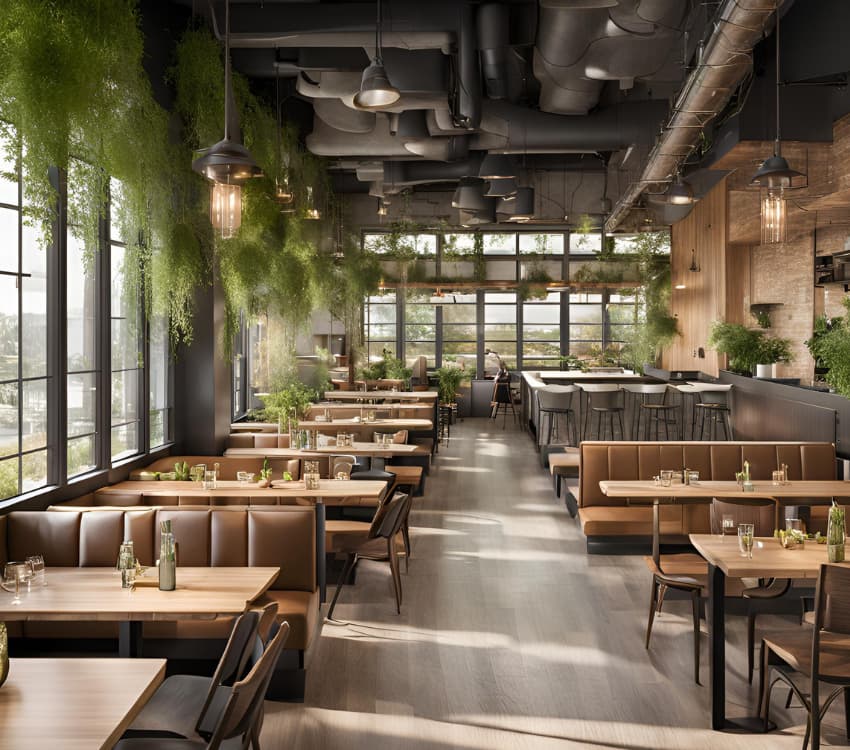As the dining industry evolves, 2025 brings exciting design trends that balance functionality, sustainability, and style. Restaurants and cafés are now more than just places to eat—they’re spaces designed to captivate, connect, and inspire innovations shaping these spaces this year, from flexible layouts to immersive interiors.

Multi-Purpose Spaces
Flexibility is at the heart of modern design. Restaurants and cafés are moving away from static layouts, opting for versatile spaces that adapt to different occasions. Modular furniture and movable partitions allow venues to seamlessly transition between bustling lunch crowds, cosy dinners, and private events. This adaptability optimises seating and ensures that every guest feels at ease, regardless of their group size or purpose for visiting.
Sustainability in Design
Eco-conscious design is more than a trend; it’s an expectation. In 2025, venues are embracing sustainable practices using reclaimed wood, energy-efficient lighting, and water-saving fixtures. Locally sourced materials reduce environmental impact and enhance a space’s character. These thoughtful choices resonate with diners who prioritise sustainability, fostering loyalty and trust.
Bringing Nature Indoors
Nature-inspired interiors flourish, with plants, natural light, and organic materials transforming dining spaces into calming retreats. Living walls, skylights, and wooden textures create an atmosphere that feels both inviting and grounded. This approach isn’t just visually appealing—it also improves air quality and promotes a sense of well-being, making diners feel more connected to their surroundings.
Bold, Art-Inspired Interiors
Vibrant colours, textured finishes, and striking art installations are redefining restaurant and café interiors. These spaces are becoming destinations in their own right, offering unique backdrops that diners love to photograph and share. From bespoke murals to playful lighting, bold designs ensure a venue stands out while staying true to its brand identity.
Technology-Enhanced Experiences
Tech integration has revolutionised how diners interact with spaces. Digital menus, contactless payments, and smart kitchen appliances streamline operations and enhance convenience. Augmented reality features and interactive displays also make appearances, adding a touch of novelty to dining experiences. These innovations cater to tech-savvy guests while improving overall efficiency.
Celebrating Local
Restaurants and cafés are increasingly reflecting their local communities through design. Regional artwork, historical references, and locally sourced furnishings create authentic and authentic spaces in their environment. This approach celebrates local culture and strengthens community ties, turning first-time visitors into loyal regulars.
Bar and Lounge Areas
Bars are evolving into versatile social hubs. Thoughtfully designed seating, adaptable lighting, and innovative drink menus are transforming them into restaurant focal points. These areas are now just as suitable for casual gatherings as for more intimate moments, offering something for every guest while boosting revenue.
Outdoor Dining Reimagined
Outdoor spaces are being redefined to offer comfort year-round. Features like retractable roofs, patio heaters, and weatherproof furniture ensure diners can enjoy alfresco meals in any season. These adaptable spaces provide a relaxed atmosphere while catering to changing weather conditions, making them a valuable addition to any venue.
The Return of Open Kitchens
Open kitchens continue to gain popularity, breaking down barriers between diners and chefs. This transparency fosters trust and engagement, allowing guests to witness the craftsmanship behind their meals. Theatrical elements, such as chef demonstrations and communal seating, add an interactive touch that enhances the overall experience.
Immersive and Experiential Dining
Dining is no longer just about food—it’s about the entire experience. Themed interiors, sensory elements like soundscapes and curated lighting, and storytelling through design create memorable visits that diners are eager to share. These immersive spaces encourage repeat visits and ensure a venue remains at the top of mind.
Designing for a Better Future
As we look to 2025, we focus on creating spaces that balance innovation with comfort and sustainability. Whether through adaptable layouts, eco-conscious materials, or immersive designs, these trends reflect a deeper understanding of what modern diners want. For restaurants and cafés, investing in thoughtful design isn’t just about aesthetics—it’s about creating lasting impressions and staying ahead in an ever-competitive industry.
At BE Furniture Sales, we understand the vital role high-quality, versatile furniture plays in bringing these design concepts to life. As a trusted restaurant, cafés, and bistros supplier, we offer a wide range of durable, stylish, and practical cafe furniture solutions to meet your design needs. Whether you’re furnishing a cosy café or a bustling bistro, our selection is crafted to complement your vision while withstanding the demands of daily use. With BE Furniture Sales, you can create inviting spaces embodying the latest trends and keep your guests returning for more.
Related Articles
- Fish & Chip Shop Trends into 2025
- Maintenance Tips for Restaurant & Cafe Furniture
- Time to Rethink Your Restaurant Furniture
- Colour in Restaurant Design
- Café Trends to Watch in 2024